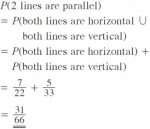Two questions on probability that I do not understand. Usually when I read the solutions to the questions, I would be able to understand where the answers are coming from but these two have been bugging me because it doesn't make any sense to me.
Q1: 6 coins are thrown at once.
Solution:
Q2:

Solution:



Question 1(b), why do we divide the answer in 1(a) with 26?
For question 2, I can't figure out why we're going to divide the number of combinations of taking 2 from 7 horizontal lines with the number of combinations of taking 2 from 12 straight lines. Why not divide it only by 12 instead, since that's total number of the lines on the plane anyway.
Thanks! Probability has been driving me nuts for the past couple of days. It's really difficult.
Q1: 6 coins are thrown at once.
(a) Among the 6 coins, how many combinations are there for 2 heads and 4 tails?
(b) Find the probability that there are 2 heads and 4 tails.
(b) Find the probability that there are 2 heads and 4 tails.
Solution:

Q2:
Solution:



Question 1(b), why do we divide the answer in 1(a) with 26?
For question 2, I can't figure out why we're going to divide the number of combinations of taking 2 from 7 horizontal lines with the number of combinations of taking 2 from 12 straight lines. Why not divide it only by 12 instead, since that's total number of the lines on the plane anyway.
Thanks! Probability has been driving me nuts for the past couple of days. It's really difficult.
Last edited:
